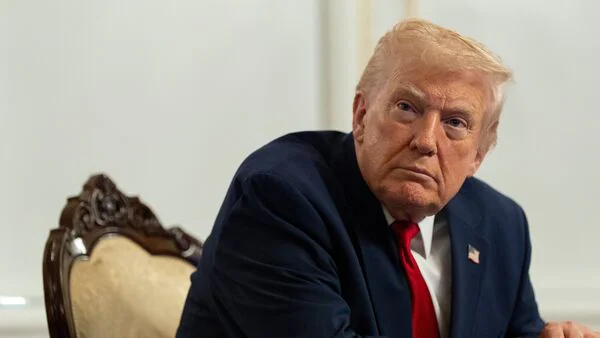
Trump's 'Third World' Migration Ban: What It Means, Which Countries Are Included And Where Does India Stand? Explained
On his social media platform, Donald Trump declared:
“I will permanently pause migration from all Third World Countries to allow the US system to fully recover, terminate all of the millions of Biden illegal admissions, including those signed by Sleepy Joe Biden's autopen, and remove anyone who is not a net asset to the United States.”
Also Read | Donald Trump claims only he can prevent Third World WarDonald Trump added that he would end federal benefits for“non-citizens,”“denaturalize migrants who undermine domestic tranquility,” and deport anyone deemed a public charge, security threat, or“non-compatible with Western civilization.”
What did“Third World” originally mean?The term“Third World” was never designed as an economic label. As World Population Review explains, it was coined in 1952 by French historian Alfred Sauvy to describe countries that were not aligned with either of the dominant Cold War blocs.
Under this original three-world model:
- First World: US-led democratic, capitalist bloc, NATO Second World: Soviet-led Communist bloc Third World: Non-aligned countries
Under this geopolitical definition, even today's wealthy nations - including Sweden, Finland, Ireland and Switzerland - were technically“Third World” because they remained neutral. The term therefore had little to do with poverty or development.
How did the meaning of 'Third World' change?After the end of the Cold War in the early 1990s, the term drifted into popular usage as shorthand for poor or underdeveloped countries, losing its original political meaning.
Also Read | Trump's crackdown on 'Third World countries': Pause on all migration - Full listIn modern discourse,“Third World” is widely used - though increasingly criticised - to refer to countries facing:
- High poverty rates Economic instability Limited industrialisation Weak social infrastructure Environmental vulnerability
This imprecise shift has generated confusion: the same country could be“Third World” under one definition and solidly high-income under another.
Are 'Third World' countries same as UN-listed Least Developed Countries (LDCs)?No. The United Nations uses formal development classifications, not Cold War terminology.
The UN recognises 44 Least Developed Countries (LDCs), based on structural economic vulnerability and low income. These include:
- Africa: 33 nations Asia: 8 (including Afghanistan, Bangladesh, Nepal, Myanmar) Caribbean: Haiti Pacific: 3 island states
LDC status comes with special trade access, aid, and development concessions. Importantly, the UN does not use“Third World” at all.
Is India a 'Third World' country?It depends entirely on which definition is applied - and Trump offered none.
Under the original Cold War definition, India was non-aligned and therefore historically counted as“Third World.”
Also Read | Third World War not beyond realm of possibility: UN General Assembly PresidentUnder modern development metrics, India is classified as a developing country, not an LDC. It is not among the UN's 44 least developed nations.
However, according to World Population Review's 2025 classification using the Human Development Index, India's HDI score of 0.685 places it on their list of“Third World” countries - a controversial rebranding that many scholars reject.
In other words:
- By UN standards: India is not in the poorest category. By Cold War logic: India was historically Third World. By Trump's undefined terminology: India's status remains unclear.
Because Trump did not specify the criteria - political, economic, historical, or security-based - there is no authoritative list of countries his order might target.
If he refers to the Cold War definition, many prosperous Western nations would be affected.
Also Read | What a third world war would mean for investorsIf he refers to the modern (and vague)“Third World = poor” definition, a substantial part of Asia, Africa, Latin America and the Pacific would fall under the category.
If Donald Trump intends to use UN LDC status, the list narrows to 44 countries - but Trump did not say so.
How Trump's statement could impact migration from South Asia?Trump's undefined use of the term“Third World” creates significant uncertainty for South Asian nations, many of which fall into broad“developing country” classifications that could easily be interpreted as part of the proposed migration pause.
Also Read | 'Trump acting like third world dictator': Senator Mark Warner at #HTLS2020Should the administration apply a wide economic definition, countries such as India, Pakistan, Bangladesh, Nepal and Sri Lanka could all face new restrictions on visas, family reunification, student mobility and employment pathways.
A blanket freeze would disproportionately affect India - currently the largest source of skilled migrants and foreign students in the United States - and could severely disrupt tech-sector staffing, graduate education pipelines and remittance flows across the region.
Legal Disclaimer:
MENAFN provides the
information “as is” without warranty of any kind. We do not accept
any responsibility or liability for the accuracy, content, images,
videos, licenses, completeness, legality, or reliability of the information
contained in this article. If you have any complaints or copyright
issues related to this article, kindly contact the provider above.

















Comments
No comment